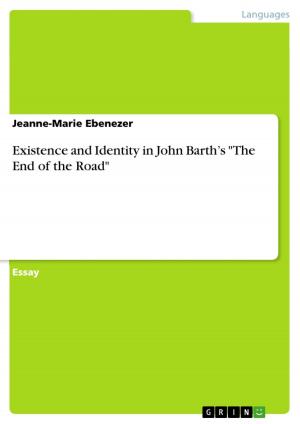How To Scare A Monster - The Philosophy of Monsters, Inc.
The Philosophy of Monsters, Inc.
Fiction & Literature, Literary Theory & Criticism, British| Author: | Andrea Schäfer | ISBN: | 9783638611589 |
| Publisher: | GRIN Publishing | Publication: | February 17, 2007 |
| Imprint: | GRIN Publishing | Language: | English |
| Author: | Andrea Schäfer |
| ISBN: | 9783638611589 |
| Publisher: | GRIN Publishing |
| Publication: | February 17, 2007 |
| Imprint: | GRIN Publishing |
| Language: | English |
Seminar paper from the year 2006 in the subject English Language and Literature Studies - Literature, grade: 2,0, University of Freiburg, course: Monsters, Monstrosoty and Alterity In Fiction and Film, 4 entries in the bibliography, language: English, abstract: The commercial slogan of the biggest power authority in Monstropolis sounds like a common saying that could also be heard in our TV and Radio programmes. And this slogan is not the only odd similarity between our human world and the movieMonsters, Inc.(2001). The movie, one of the latest works developed by Pixar Animation Studios in cooperation with Walt Disney Pictures, is an animated movie for children that sets in a parallel universe, namely a world of monsters: Monstropolis. While this movie was not only extremely successful in the Box office and nominated for an Academy Award in 2002 for Best Animated Feature, there is a lot more to discover beyond its surface. Considering the fact that 'Monsters, Inc.' is a movie made for young people, especially for little children (rated TV-G in the US) the film needs to meet some expectations. It is clear that this movie is supposed to be funny, entertaining and suitable for children. At the same time it should be fun for the whole family, not only for the kids, because the parents form the audience that pays for the movie. Additionally, movies for kids are generally expected to fulfil a pedagogical task, as most of Disney's movies do. There is always the plea for tolerance, equality and kindness in Disney-films, like inMulan, TarzanorThe Beauty and the Beast.The story inMonsters, Inc.however, is set on a much more complex basis than the movies that have been produced by Disney so far. The image of the monster behind closet doors and under the beds of little children - usually rather nightmarish material - is used to create a whole world beyond the scary creatures. This term paper serves to provide a closer look at how the monster is presented in the movie and how this typology can be compared to the common image or stereotype of a monster as well as providing a re-framing of the concept on the basis of monster theory in literature. There will also be a short discussion of how the characters in the movie are adopting human qualities while creating an everyday-life and whether this device is only applied in entertaining the audience. In a final step, there will be an examination on how this fact influences the story in an inverse manner and thus creates a comical and ironic view on the common concepts of a monster.
Seminar paper from the year 2006 in the subject English Language and Literature Studies - Literature, grade: 2,0, University of Freiburg, course: Monsters, Monstrosoty and Alterity In Fiction and Film, 4 entries in the bibliography, language: English, abstract: The commercial slogan of the biggest power authority in Monstropolis sounds like a common saying that could also be heard in our TV and Radio programmes. And this slogan is not the only odd similarity between our human world and the movieMonsters, Inc.(2001). The movie, one of the latest works developed by Pixar Animation Studios in cooperation with Walt Disney Pictures, is an animated movie for children that sets in a parallel universe, namely a world of monsters: Monstropolis. While this movie was not only extremely successful in the Box office and nominated for an Academy Award in 2002 for Best Animated Feature, there is a lot more to discover beyond its surface. Considering the fact that 'Monsters, Inc.' is a movie made for young people, especially for little children (rated TV-G in the US) the film needs to meet some expectations. It is clear that this movie is supposed to be funny, entertaining and suitable for children. At the same time it should be fun for the whole family, not only for the kids, because the parents form the audience that pays for the movie. Additionally, movies for kids are generally expected to fulfil a pedagogical task, as most of Disney's movies do. There is always the plea for tolerance, equality and kindness in Disney-films, like inMulan, TarzanorThe Beauty and the Beast.The story inMonsters, Inc.however, is set on a much more complex basis than the movies that have been produced by Disney so far. The image of the monster behind closet doors and under the beds of little children - usually rather nightmarish material - is used to create a whole world beyond the scary creatures. This term paper serves to provide a closer look at how the monster is presented in the movie and how this typology can be compared to the common image or stereotype of a monster as well as providing a re-framing of the concept on the basis of monster theory in literature. There will also be a short discussion of how the characters in the movie are adopting human qualities while creating an everyday-life and whether this device is only applied in entertaining the audience. In a final step, there will be an examination on how this fact influences the story in an inverse manner and thus creates a comical and ironic view on the common concepts of a monster.















